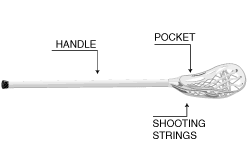Lacrosse Sticks
Position and skill level are just some of the factors that influence your stick choice. Learn more here.
How To Buy A Lacrosse Stick
The lacrosse stick is an essential piece of equipment for the lacrosse player, and the type of stick you buy depends on a number of factors, including your position, skill level, and gender.
Types of sticks
Lacrosse sticks come in a variety of lengths and styles according to position and type of game played, with cost and durability as additional factors.
Men's
- Men's sticks generally have an aluminum handle
- All manufacturers now make more technically advanced sticks made ofaluminum, graphite or even titanium
- These styles are generally more lightweight and durable than wood sticks, but more expensive
- Men use either a traditional or meshpocket depending on their position and playing style
Women's
- Women's sticks have either a wood or aluminum handle
- Wood sticks, like wooden baseball bats, are prone to damage and breaking
- These sticks utilize a traditional pocket
- The head on a women's stick is 1 inch above the center stop
- The head has an overall length of 10-12 inches
- Women's stick pockets are shallower than men's. The pockets must have 4 or 5 leather thongs and no more than 2 shooting strings.
Kids'
- Plastic sticks are primarily used by younger players just learning the sport
- These are lighter, easier to break in and more durable than the models for more advanced players
- They usually utilize a mesh netting
- The plastic stick's pointed mouth makes it easier for younger players to pick up the ball and throw it accurately
Anatomy of a lacrosse stick
Handles
- The type of handle you buy is very much a matter of preference
- Some players like heavy, thick handles for defensive purposes
- Attacking players generally prefer lighter, rounder handles for better faking and maneuverability
- Some players prefer square shaped handles for a better feel on which way thehead is facing
Pocket types
Lacrosse sticks come with either a traditional woven pocket for more experienced players or a mesh pocket for novices. They also can be bought strung or unstrung.

- Traditional pockets
- These consist of nylon laces woven around 4 adjustable strips of leather
- The leather strips can be adjusted to fit any type of shot. They do need to be replaced after repeated use.
- A stiffer pocket is more accurate but gives less control while running and moving
- Mesh pockets
- They are made of a nylon webbing woven into the side of the pocket and require little or no adjustment
- Mesh pockets are looser and give less accuracy on passes and shots, but make it easier to control the ball when running
- These require less maintenance than traditional pockets
- The mesh netting does not control or absorb the ball as well as leather netting
- Goal keepers tend to prefer mesh netting because it reduces rebounds
- Pocket depth
- Pocket depth is mostly a matter of preference and playing style
- Generally, a deeper pocket provides more feel and ball control, while a shallower pocket gives you a quicker release but sacrifices ball control
- Ball-control players who do a lot of short passing should use a fairly deep pocket
- Fast-break players who tend to pass the ball over longer areas should use a shallower pocket
- Overhand shooters should have an average depth pocket (a ball width or less)
- Sidearm and underhand shooters should have depths of a ball or more
- Shooting strings
- Shooting strings, positioned horizontally near the top of the stick's head, affect the ball's balance and direction
- Overhand passers usually put in 3 or 4 shooting strings to make a smooth path for the ball to run out of the pocket. Heavy skate laces are best used for this.
- The shooting strings determine whether your shot will have "whip,"which occurs when the ball is released smoothly and gradually. Experienced players prefer a whippy release.
Proper stick length according to position
The length of your stick depends almost entirely on the position you play.
- Attackers should buy a stick that is close to the minimum length of 30 inches to allow for more control and maneuverability
- Midfielders should buy a slightly longer medium-length stick to allow them to play both offense and defense
- Defenders should use the longest stick they are comfortable with, usually around 60 inches, for greater reach
- Goaltender sticks are generally 42 inches long
- Younger players should make sure they choose a stick that fits them comfortably, regardless of position. It is more important to be able to handle the stick and ball comfortably.
- Women's sticks range only from 36 to 44 inches. The exact length depends on the position--longer (43-44 inches) for defenders, shorter (36 inches) for attackers.
